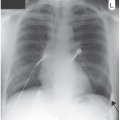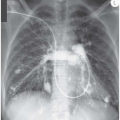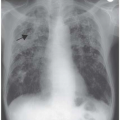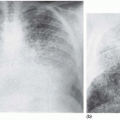The Hypoxaemic Patient with a Normal Chest Radiograph
Breathlessness is one of the commonest presenting complaints of emergency medical patients and many of them have a normal chest radiograph. These patients deserve considerable thought rather than merely being consigned to the easy diagnostic buckets of ‘chest infection’ or ‘hyperventilation’. A diverse group of medical conditions are capable of causing profound breathlessness without announcing themselves on a chest radiograph and one in particular can prove fatal if undiagnosed.
In this situation, an early step is to ascertain if subjective breathlessness is accompanied by physiological derangement, i.e. hypoxaemia. This cannot be decided simply through arterial oxygen saturation or even with arterial blood gas estimation but only after a thorough analysis of gas exchange. Because of the frequency with which I have seen inadequate assessment of this common clinical scenario, I think it is justified to devote a chapter to its consideration. Anyone dealing with acute medical patients should be aware of the potential diagnoses that explain physiological abnormality (i.e. abnormal gas exchange) in the breathless patient who has no anatomical evidence of disease on his or her chest X-ray. Another justification for including this chapter in a publication that aims to teach X-ray interpretation is that although many of the responsible pathologies are not accompanied by abnormality on the chest X-ray, alternative imaging techniques are far from normal.
This chapter considers three disparate pathological groups: (1) pulmonary vascular disease (particularly of thromboembolic aetiology); (2) airway diseases; and (3) a heterogeneous mix of conditions causing alveolitis, none of which may be detectable on a plain radiograph during the early stages of their natural history.
First, though, it is essential to consider some basic pulmonary physiology in order to follow the diagnostic steps in managing the breathless patient with a normal radiograph.
STEP ONE
Is your patient hypoxaemic as well as breathless? In most emergency departments these days arterial oxygen saturation is a routine measurement and a significant proportion of breathless patients will have arterial blood gases taken as well. However, in my experience, the interpretation of these tests is seldom complete. Let us take an example (a real case) of a 23-year-old, breathless woman whose arterial oxygen saturation (SaO2) breathing air was 96 per cent.
Can we be completely reassured by the normal oxygen saturation? The answer is ‘No’ for two reasons. First, the shape of the oxygen dissociation curve means that a SaO2 of 96 per cent can be achieved with an arterial oxygen tension (paO2) that may be far from normal in a 23-year-old person. Second, both oxygen saturation and oxygen tension cannot be assessed in isolation because they are both affected by the
degree of ventilation – both will increase with increasing ventilation (if the lungs are normal) and hypoventilation will have the opposite effect.
degree of ventilation – both will increase with increasing ventilation (if the lungs are normal) and hypoventilation will have the opposite effect.
In the example quoted, blood gases were checked, revealing a normal paO2 at 12.5 kPa, a low arterial carbon dioxide tension (paCO2) of 3 kPa and a pH of 7.49. The low paCO2 indicated that the patient was hyperventilating and, because the paO2 was normal, primary hyperventilation was diagnosed. This conclusion was dangerously wrong because no objective calculation had been made of the paO2 that might be expected for the degree of hyperventilation if oxygen exchange was normal.
A fundamental point is that the measured paO2 is affected by the inspired oxygen concentration (FIO2) and the degree of alveolar ventilation (VA), as well as the effectiveness or integrity of lung function, which dictates the ability to transfer oxygen from the alveolar space to the pulmonary capillaries.
If lung function is normal, an increase in FIO2, VA or both will result in an increase in paO2. A fall in FIO2 or VA will have the opposite effect. It follows that paO2 cannot provide an accurate assessment of lung function on its own; it must be examined in relation to what is happening in the alveolar space where the alveolar concentration of oxygen (FAO2) and therefore its partial pressure (pAO2), is influenced by both FIO2 and VA. This young woman’s measured arterial carbon dioxide tension (paCO2) was low and, because the transport of carbon dioxide from pulmonary capillary to lung alveolus is highly efficient, we know that her alveolar carbon dioxide tension (pACO2) would have approximated very closely to paCO2 at 3 kPa. Second, the total pressure of alveolar gases must equal atmospheric pressure and if the partial pressure of carbon dioxide in the alveoli falls, the contribution from another gas must rise in order to compensate (otherwise the individual would implode!). The alveolar nitrogen component of inspired air remains constant and so in normal situations this leaves only oxygen to make up for the deficit – in other words, as pACO2 falls, pAO2 will rise. The opposite is also true; an increase in pACO2 (usually due to hypoventilation) results in a fall in pAO2.
Going back to the example of the young woman, we are right to infer that a paCO2 of 3 kPa would have resulted in a pAO2 of more than 12.5 kPa and that her paO2 should have been correspondingly higher if lung function had been normal. Unlike CO2, the transfer of oxygen is never perfect (because of an unavoidable degree of ventilation-perfusion mismatch) and this means that there is always an alveolar-arterial oxygen difference (pAO2 – paO2), which increases with age. Rather than guessing, we should be precise about the paO2 that can be expected for a particular paCO2 (which reflects the degree of VA) and the first step is to calculate pAO2. This is straightforward because pAO2 is easy to calculate using the modified alveolar gas equation as follows:
where R is the respiratory quotient (0.8 under most conditions) and pIO2 is 21 per cent of atmospheric pressure (101 kPa). Saturated water vapour pressure is 6.5 kPa and therefore the partial pressure of oxygen in inspired air is 21 per cent of 94.5 kPa, i.e. 19.845 kPa (or 20 for simplicity).
If we return to the example quoted:
Blood gases measure paO2 and the alveolar-arterial oxygen difference (pAO2 – paO2) can therefore be calculated and compared with normal values:
pAO2 – paO2 correlates with the degree of ventilation-perfusion mismatch and therefore provides direct information on the integrity of lung function. A gradient of more than 2 kPa is very questionable in a 23 year old and one of 3.75 is definitely abnormal. In other words, by completing this simple calculation, we have shown that the patient is hyperventilating in order to compensate for abnormal oxygen exchange and to avoid hypoxaemia. This is not primary hyperventilation, there is something wrong with her lung function. Moreover, the abnormal physiology is not matched by any pathology that is visible on the chest radiograph and this discrepancy has to be explained.
The above equation is ‘modified’ because it ignores the fact that we consume a larger volume of oxygen than we produce carbon dioxide. Therefore, with each respiratory cycle the inspired volume of alveolar gas is slightly greater than the expired volume and this is reflected in the full alveolar gas equation. However, the full equation is much more complicated and, in practice, when calculating pAO2 using the modified method, the inherent error is only a fraction of a kilopascal (kPa) and can be ignored in most clinical situations.
Calculating alveolar oxygen tension in this way becomes increasingly less reliable as the inspired oxygen tension increases. The patient should be breathing air to allow a meaningful calculation, but do not take a hypoxaemic patient off oxygen just to calculate the pAO2 – paO2 gradient – this is not just pointless, it is dangerous.
Ventilation-perfusion mismatch and its correlate, the pAO2 – paO2 gradient, both increase with age. A rough estimate of normal values at different ages is given by the equation first described by Mellemgaard et al. in the 1960s:
STEP TWO
This is a short but important step. Consider alternative blood gases in a young man: paO216.5 kPa, paCO22 kPa, pH 7.37
The A-a gradient calculates out at 1 kPa, which is completely normal. The patient is definitely hyperventilating and his lung function is good. However, before diagnosing primary hyperventilation, the parameters of acid-base balance must be examined. This was a real example in a 19-year-old man who had taken a salicylate overdose and was hyperventilating in order to correct for a metabolic acidaemia. The fall in paCO2




Stay updated, free articles. Join our Telegram channel

Full access? Get Clinical Tree






